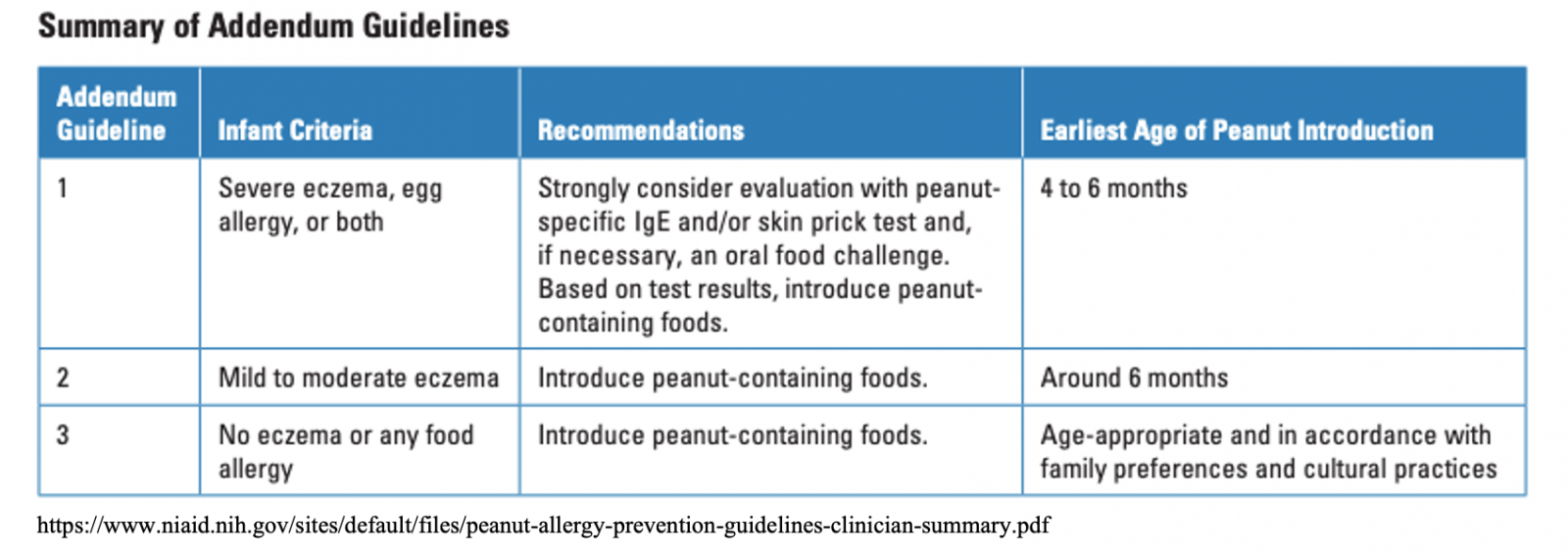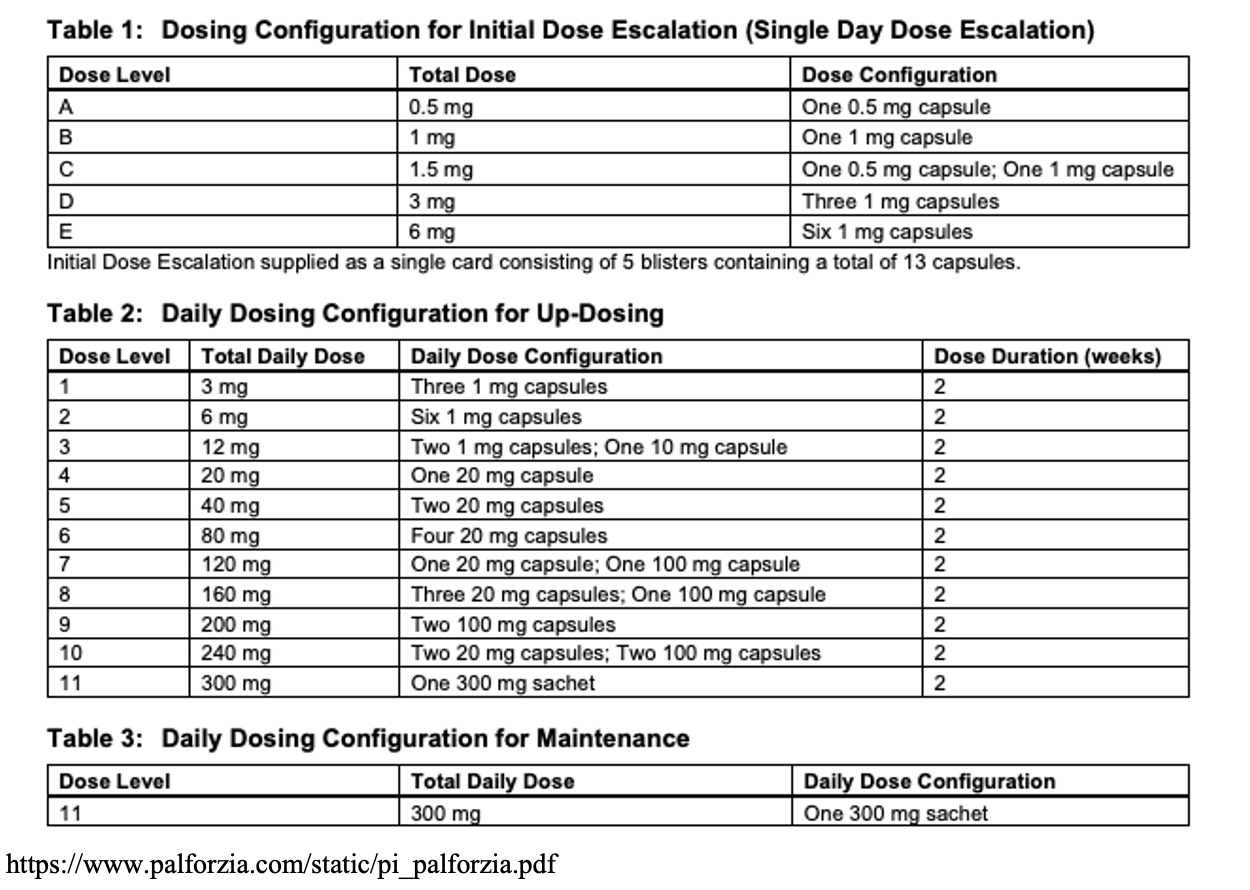Article
Clinical Insights: Palforzia is the First FDA-approved Treatment of Peanut Allergy
Peanut allergies affect approximately 1.2% of the entire US population and an estimated 2.5% of the childhood population.
BACKGROUND
In January 2017, the National Institute of Allergy and Infectious Diseases (NIAID) published an addendum guideline to prevent peanut allergy in the United States. It is for pediatricians to introduce peanut based on patient risk levels: assessment from previous egg allergy history and/or eczema. The summary includes guidelines with 3 different categories based on the child’s risk level and when to introduce peanut to their diet (Figure 1).

A study was done to assess how much of these guidelines were known and used among pediatricians across the United States. They found that among 1781 surveyed pediatricians, “93% knew about the guidelines, 29% of those fully implemented them, and 64% partially implemented them.”
This study also concluded that understanding and implementing these guidelines were necessary to improve adherence and decrease the incidence of peanut allergy among children.
Peanut allergies affect approximately 1.2% of the entire US population and an estimated 2.5% of the childhood population. According to the FDA’s Center for Biologics Evaluation and Research, approximately 1 million children have a peanut allergy and only 20% of them can outgrow their allergy.
It is also the most common food allergy in kids (25%) and the number 1 cause of death related to allergy in children. In a recent study, there was a 21% increase of peanut-allergy cases in the United States since 2010. This number is expected to rise over the next several years.
Their quality of life is affected because they always have to keep track of what they eat. Financially, they also have to carry anti-anaphylaxis medications for emergency situations, which tend to cost in the hundreds of dollars per kit. (Micromedex Red Book).
MECHANISM OF ACTION
The exact mechanism of action of Palforzia [Peanut (Arachis hypogaea) allergen Powder-dnfp] is not known. It is a peanut protein in a form of powder made from defatted peanut flour.
Allergic reactions to peanut occur when the body’s immune system recognizes peanut allergen as harmful, which produces allergic reactions, such as hives, swelling, redness, digestive problems, or even dangerous reactions such as anaphylaxis.
Palforzia is thought to work as an oral immunotherapy in which the body is slowly exposed to a small amount of allergen with increased dosing exposure over a long period of time.
CLINICAL TRIAL
A phase 3, randomized, double-blind, placebo-controlled trial was conducted with 500 patients from 4 to 55 years of age with peanut allergy across the United States, Canada, and Europe. For patients who completed the trial (4-17 years old): 96.3%, 84.5%, and 63.2% of the patients tolerated single dose of Palforzia 300 mg, 600 mg, and 1000 mg, respectively, with no more than mild allergic symptoms for 6 months compared with 8.6%, 4.3%, and 2.6% of placebo patients.
DOSING and ADMINISTRATION
Over the course of 6 months, treatment consists of 3 phases—initial dose escalation, up-dosing, and maintenance. Initial dose escalation phase and first dose of levels 1-11 of up-dosing phase are given in a Risk Evaluation and Mitigation Strategy (REMS)-certified health care setting to manage patients.

While on treatment, patients are not allowed to have any peanuts in their diet. It is also not indicated for emergency treatment or anaphylactic reactions. The capsules/sachets are opened, and contents are mixed with small amount of apple sauce, yogurt, or pudding for administration.
ADVERSE EFFECTS (AEs) and REMS
Common AEs are stomach discomfort, vomiting, feeling sick, itching or burning of mouth, throat irritation, cough, runny nose, sneezing, throat tightness, wheezing, itchy skin, and hives.
REMS
Palforzia can cause life-threatening allergic reactions or anaphylaxis. Due to this, it is only available through a REMS program required by FDA, which ensures that patients are safe and monitored closely. Health care settings, prescribers, pharmacies, and patients who administer, prescribe, or dispense Palforzia must be enrolled in the Palforzia REMS program.
PRICING
Palforzia costs from $2.77 to $35.60 per unit, depending on the different dosages. Aimmune, the biopharmaceutical company that developed Palforzia, listed the monthly price at $890 and an annual price of approximately $11,000 per year.
Due to the high cost of this medication, several programs were made to assist patients financially, which all are found at the website. The Palforzia Pathway Support Program helps patients to understand their insurance coverage and financial assistance options for the medication.
The Palforzia Pathway Patient Assistance program gives Palforzia at $0 to eligible patients (ie, no insurance or if insurance denied coverage). The program also gives patients a co-pay as low as $20 per month for eligible commercially insurance.
About the Author
Ellane Guiao is a is a PharmD candidate at Marshall B. Ketchum University’s College of Pharmacy, anticipated to graduate in Spring 2021.
Jonathan Ogurchak, PharmD, CSP, is the CEO and Co-Founder of STACK, a professional information management platform, and serves as preceptor for a virtual Advanced Pharmacy Practice Experiential Rotation for specialty pharmacy, during which this article was composed.
References
- Palforzia. (n.d.). Retrieved September 18, 2020, from https://www.palforzia.com/?js=aw
- Peanut allergen oral immunotherapy powder: Drug information. UpToDate. Accessed on September 18,2020. Available from https://www-uptodate-com.eproxy.ketchum.edu/contents/peanut-allergen-oral-immunotherapy-powder-drug-information?search=palforzia&source=panel_search_result&selectedTitle=1~5&usage_type=panel&kp_tab=drug_general&display_rank=1
- Cannon, Eric. “The Economic Impact of Peanut Allergies.” The American Journal of Managed Care , 2018, www.ajmc.com/view/the-economic-impact-of-peanut-allergies.
- “Peanut Allergy.” American College of Allergy, Asthma, and Immunology, 14 Mar. 2019, acaai.org/allergies/types/food-allergies/types-food-allergy/peanut-allergy.
- “Addendum Guidelines for the Prevention of Peanut Allergy in the United States.” National Institute of Allergy and Infectious Diseases, Jan. 2017, www.niaid.nih.gov/sites/default/files/peanut-allergy-prevention-guidelines-clinician-summary.pdf.
- Patrawala M, Shih J, Lee G, Vickery B. Peanut Oral Immunotherapy: a Current Perspective. Curr Allergy Asthma Rep. 2020;20(5):14. Published 2020 Apr 20. doi:10.1007/s11882-020-00908-6
- Gupta RS, Bilaver LA, Johnson JL, et al. Assessment of Pediatrician Awareness and Implementation of the Addendum Guidelines for the Prevention of Peanut Allergy in the United States. JAMA Netw Open. 2020;3(7):e2010511. Published 2020 Jul 1. doi:10.1001/jamanetworkopen.2020.10511
- Tomar S, Hogan SP. Recent advances in mechanisms of food allergy and anaphylaxis. F1000Res. 2020;9:F1000 Faculty Rev-863. Published 2020 Jul 31. doi:10.12688/f1000research.25638.1
- Commissioner, Office of the. “FDA Approves First Drug for Treatment of Peanut Allergy for Children.” U.S. Food and Drug Administration, FDA, 2020, www.fda.gov/news-events/press-announcements/fda-approves-first-drug-treatment-peanut-allergy-children.
- Gardner, Jonathan. “FDA Approves Aimmune Drug as First Treatment for Peanut Allergy.” BioPharma Dive, 31 Jan. 2020, www.biopharmadive.com/news/aimmune-fda-approval-palforzia-peanut-allergy/571524/.





